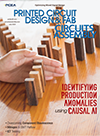New Products
LeadTracer-RoHS XRF now can be used in solar applications to ensure RoHS compliance. The solder analysis and identification feature identifies all solder alloys within minutes. Addresses various potential weak links in production chain, especially in a dual-alloy manufacturing operation. Includes boards for second-side assembly on a non-continuous line; boards taken off-line for inspection and analysis; reflow boards moving to wave or selective soldering; boards split into two batches; boards moving from production to rework areas; boards held for missing parts or for component recovery; components held in rework areas, and components from placement reject trays. Is designed to screen RoHS/WEEE and common elements in electronics and solar equipment, including China RoHS. Can conduct daily solder pot analysis. Is now available with a sample preparation stand that is equipped with quick disconnect grip.
RMD Instruments Corp., www.rmd-leadtracer.com
Paragon bond testing software provides flexible analysis, high-accuracy and repeatability of test data. Monitors all aspects of bondtester: life tests on the tool, load cartridge, calibration jig and health checks. Has a configurable interface. Includes accessible test setup parameters, a checklist enabling quick start; semi-automatic test routines, and a database search engine wizard. Data presentation is enhanced by charting functionality; several graphs can be displayed at once, including camera images. Reportedly guarantees consistency of test data; includes failure mode grading.
Nordson Dage, www.nordsondage.com
Sarcon GR-Tac is a 0.25-mm thick polyester reinforced thermal interface material. Is reportedly easy to install and typically does not require adhesive; ideal for applications where surface space and textures vary. Is suited for low- and high-volume production runs. When placed between a heat source and a nearby heat sink, Sarcon TIM will transfer heat with a thermal conductivity of 1.5 W/m°K and a thermal resistance as low as 0.33 °Cin2/W. Polyester mesh construction is ideal for most die-cut installations. Is available in sheets up to 300 mm x 200 mm.
Fujipoly America Corp., www.fujipoly.com
Reflow Oven Cleaner is a formulated micro-emulsion for cleaning reflow ovens and wave solder machines. Is a nonflammable, low toxicity and odor solvent for removing all types of flux residues. Is said to prevent buildup of condensed flux residues. Can be used at temperatures of 20°-50°C, with an optimum working temperature of 40°C. Contains inhibitors to prevent corrosion to both ferrous and non-ferrous metals and is compatible with most plastics. Also suitable for many general degreasing applications.
Electrolube, www.electrolube.us.com
TimingDesigner 9.25 has enhanced Automerge functionality said to dramatically speed interface timing analysis. Permits use of reusable, model-based approach to timing analysis. Connects component timing models to create parameterized interface diagrams that can be used to validate timing and interactively test design alternatives. Interface models can be created early in the design phase to help drive constraint definition and timing budgeting. Propagation delay and signal integrity effects can be added for a more accurate representation of timing margins. Optional TimingDesigner Design Kit Library, for automated analysis process. Also updates Allegro PCB SI flow and features new design validation commands to identify critical margins, ensure proper analysis, and determine timing closure.
EMA Design Automation, www.timingdesigner.com/whatsnew
McDry Signal Tower with ERC-301AD hygrometer with an alarm system and a wireless temperature/humidity data logger are for McDry electronics drying storage cases. A light signal flashes and an audible alarm sounds when humidity level goes over the set limit for a fixed period of time. After the alarm flashes, the unit saves 10 data readings: one per hr. The data logger permits viewing and tracking of temperature and RH levels within the cabinet to ensure safe storage of moisture-sensitive components and materials. Export data to Excel. No nitrogen needed; humidity is removed by use of a zeolite desiccant, which is recycled automatically and does not require replacement.
Seika Machinery Inc., www.seikausa.com
Press Releases
- Pushed by glass core and high-end ICs substrates for AI, the advanced IC substrate market reaches $31 billion by 2030
- Pushed by glass core and high-end ICs substrates for AI, the advanced IC substrate market reaches $31 billion by 2030
- Ryder Vietnam - Phase 2: Building resilience and meeting demand
- Scanfil and Etteplan deepen their strategic partnership into production testing


